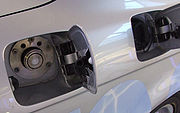
Hydrogen internal combustion engine vehicle
Encyclopedia


Hydrogen vehicle
A hydrogen vehicle is a vehicle that uses hydrogen as its onboard fuel for motive power. Hydrogen vehicles include hydrogen fueled space rockets, as well as automobiles and other transportation vehicles...
using an internal combustion engine
Internal combustion engine
The internal combustion engine is an engine in which the combustion of a fuel occurs with an oxidizer in a combustion chamber. In an internal combustion engine, the expansion of the high-temperature and high -pressure gases produced by combustion apply direct force to some component of the engine...
. Hydrogen internal combustion engine vehicles are different from hydrogen fuel cell vehicle
Fuel cell vehicle
A Fuel cell vehicle or Fuel Cell Electric Vehicle is a type of hydrogen vehicle which uses a fuel cell to produce electricity, powering its on-board electric motor...
s (which use hydrogen + oxygen rather than hydrogen + air); the hydrogen internal combustion engine is simply a modified version of the traditional gasoline-powered internal combustion engine.
History
Francois Isaac de RivazFrançois Isaac de Rivaz
François Isaac de Rivaz was a French politician, chancellor, Deputé , entrepreneur and inventor. In retirement, as a Swiss citizen, circa 1807, he invented a hydrogen powered internal combustion engine with electric ignition...
designed in 1806 , the De Rivaz engine
De Rivaz engine
The de Rivaz engine was a pioneering reciprocating engine designed and developed from 1804 by the Franco-Swiss inventor Isaac de Rivaz. The engine has a claim to be the world's first internal combustion engine and contained some features of modern engines including spark ignition and the use of...
, the first internal combustion engine, which ran on a hydrogen/oxygen mixture. Étienne Lenoir
Etienne Lenoir
-Sources:* Georgano, G.N. Cars: Early and Vintage 1886-1930. London: Grange-Universal, 1990 . ISBN 0-9509620-3-1....
produced the Hippomobile
Hippomobile (car)
The Hippomobile is an automobile invented by Étienne Lenoir in 1863 which carried its own internal combustion engine. It was based on his 1860 invention the Lenoir gas engine...
in 1863. Paul Dieges patented in 1970 a modification to internal combustion engines which allowed a gasoline-powered engine to run on hydrogen.
Mazda has developed Wankel engine
Wankel engine
The Wankel engine is a type of internal combustion engine using an eccentric rotary design to convert pressure into a rotating motion instead of using reciprocating pistons. Its four-stroke cycle takes place in a space between the inside of an oval-like epitrochoid-shaped housing and a rotor that...
s that burn hydrogen. The advantage of using ICE (internal combustion engine) such as wankel and piston engines is that the cost of retooling for production is much lower. Existing-technology ICE can still be used to solve those problems where fuel cells are not a viable solution as yet, for example in cold-weather applications.
Recently, BMW
BMW
Bayerische Motoren Werke AG is a German automobile, motorcycle and engine manufacturing company founded in 1916. It also owns and produces the Mini marque, and is the parent company of Rolls-Royce Motor Cars. BMW produces motorcycles under BMW Motorrad and Husqvarna brands...
tested a supercar, fueled by a hydrogen ICE, which achieved 187 mph (301 km/h) in tests. At least two of these concepts have been manufactured.
HICE forklift trucks have been demonstrated based on converted diesel internal combustion engines with direct injection.
Low Emissions
The combustion of hydrogen with oxygen produces water as its only product:- 2H2 + O2 → 2H2O
The combustion of hydrogen with air can also produce oxides of nitrogen, though at negligibly small amounts. Tuning a hydrogen engine to create the most amount of emissions as possible results in emissions comparable with consumer operated gasoline engines from 1976.
- H2 + O2 + N2 → H2O + N2 + NOx
Adaptation of Existing Engines
Difference between a hydrogen ICE from a traditional gasoline engine could include hardened valves and valve seats, stronger connecting rods, non-platinum tipped spark plugs, higher voltage ignition coil, fuel injectors designed for a gas instead of a liquid, larger crankshaft damper, stronger head gasket material, modified (for supercharger) intake manifold, positive pressure supercharger, and a high temperature engine oil. All modifications would amount to about one point five times (1.5) the current cost of a gasoline engine. These hydrogen engines burn fuel in the same manner that gasoline engines do.The power output of a direct injected hydrogen engine vehicle is 20% more than for a gasoline engine vehicle and 42% more than a hydrogen engine vehicle using a carburetor
Carburetor
A carburetor , carburettor, or carburetter is a device that blends air and fuel for an internal combustion engine. It is sometimes shortened to carb in North America and the United Kingdom....
.
See also
- Hydrogen vehicleHydrogen vehicleA hydrogen vehicle is a vehicle that uses hydrogen as its onboard fuel for motive power. Hydrogen vehicles include hydrogen fueled space rockets, as well as automobiles and other transportation vehicles...
- Hydrogen fuel enhancement
- Liquid nitrogen vehicleLiquid nitrogen vehicleA liquid nitrogen vehicle is powered by liquid nitrogen, which is stored in a tank. The engine works by heating the liquid nitrogen in a heat exchanger, extracting heat from the ambient air and using the resulting pressurized gas to operate a piston or rotary engine...
- List of hydrogen internal combustion engine vehicles
- Timeline of hydrogen technologiesTimeline of hydrogen technologiesTimeline of hydrogen technologies — A timeline of the history of hydrogen technology.-1600s:* 1625 - First description of hydrogen by Johann Baptista van Helmont...

